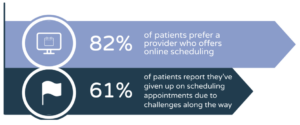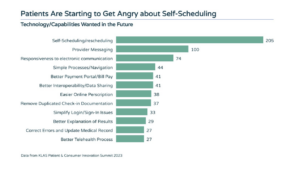Q&A: How to Get Healthcare Providers on Board with Patient Self-Scheduling
Q&A Conversation with Clearwave CEO, Mike Lamb | March 20, 2024
Patient self-scheduling has gone from a “nice-to-have” feature to a critical element in a practice’s patient acquisition, retention and growth strategy. Patients no longer want to find time in their busy days to call a healthcare practice. They want the flexibility to book appointments online anytime, anywhere, without human interaction.
The proof is in the numbers:
Patient access, empowerment and convenience are at the forefront of the industry, so why aren’t all healthcare practices adopting a digital approach?
To answer this question, we recently sat down with Clearwave CEO Mike Lamb. He shared best practices to help healthcare leaders get the support they need to make the leap to digital scheduling. Read on to find out what he had to say.
Why is digital patient scheduling in such high demand?
Patients have been enjoying easy and convenient access to consumer on-demand services for years – from booking flights and rides, to ordering food, clothes and groceries. Now, they want the same convenient access that they’re accustomed to in their healthcare experiences.
Think about it: In the age of Uber and other ride services, calling a taxi seems archaic – doesn’t it? In this context, it’s easy to see why patients no longer want to deal with phone scheduling. When almost everything else can be done online, having to make a phone call can be frustrating – not only because of the extra step but because patients are forced to make calls within confined office hours, where they can experience long hold times while staff work through the queue.
Without the freedom to self-schedule patients can get frustrated. This high demand has transformed digital self-scheduling from a new trend to a fundamental shift in how healthcare services are accessed. Just look at the KLAS reporting on where patient expectations stand…
Not only do industry stats support this idea but what we’re hearing from prospects and clients support this shift as well. Even owner and Founder at Belsher Enterprises, Jon Belsher, M.D., touches on this patient demand in our recent webinar conversation on the topic. It’s time for providers to get on board.
Are healthcare practices adopting a digital approach?
They are, high-growth healthcare practices making the shift to digital self-scheduling because they see the instrumental role it plays in acquiring new patients, keeping existing patients happy and driving revenue, while also increasing staff efficiencies.
That said, we’re seeing many cases where practices are aware of and understand these proven benefits, but have been hesitant to modernize…
Why are practices holding back?
The biggest reason is that providers fear moving to a digital self-scheduling will give patients the control they demand but at the expense of their own – so they push back on making a change to the scheduling process.
For example, when I attended the KLAS Research Summit, we discussed the common barriers to implementing self-scheduling, and the number 1 concern from providers is that they believe an online tool isn’t robust enough to meet their scheduling needs. Instead, they think human schedulers, familiar with the nuances of each physician, are required to get it right.
While providers’ concerns in this respect are certainly understandable, with smart, robust patient self-scheduling tools they are also unfounded.
There are powerful patient self-scheduling solutions available that can be tailored to meet the diverse requirements of providers – no matter how many are on staff or how unique their specifications are. These solutions enhance efficiency and minimize human error. The key advantage lies in the software’s ability to strictly adhere to pre-built workflow requirements.
What can practice owners and administrators do to ease provider hesitancy around patient self-scheduling?
The best way for healthcare leaders to ease providers’ fears and get them on board is to help them disprove their common misperceptions and share the benefits they’ll see in return.
For example, insurance eligibility plays a big role in ensuring that patients are directed to the right services based on their insurance coverage, specific healthcare needs and financial policies. By checking patient eligibility at the point of scheduling, practices and patients can avoid financial ‘surprises’ in the long run. Checking eligibility and getting patients to follow practice financial policies upon booking, are some of the top reasons providers feel that staff must manage the process.
However, humans aren’t the only ones that can conduct eligibility verification – smart scheduling solutions can, too. For example, Clearwave Scheduling automatically checks patient eligibility during booking to ensure practices get paid for the services they’re providing in the long run and receive reimbursement. By incorporating these automated features and smart logic, practices ensure patients are booked correctly and financial policies are met, so there are no challenges down the line.
Patient eligibility is just one of the five common provider misconceptions around patient self-scheduling. Review this myth and the other four provider misconceptions here — then debunk them for your providers to get them to see the potential in a self-scheduling solution! Dr. Belsher even covers those five misconceptions in this discussion on how Patient Self-Scheduling has become the Ultimate Deal Breaker. To kickstart your conversation on self-scheduling, share this conversation with your providers, they may resonate with Dr. Belsher’s experiences and recommendations.
Is there any other advice you want to share with healthcare practices and providers?
Patients are demanding self-scheduling, so practices need to respond – or they risk being left behind. And why would you wait? Digital self-scheduling has proven benefits across the board – from enhancing patient satisfaction, acquisition and retention, to increasing practice efficiency, reducing the workload on front office staff and keeping providers happy.
Remember, there’s a difference between requesting appointments and booking them. Patients don’t want to go through the scheduling process to simply request an appointment. When this happens, they still need to wait for staff to confirm their appointment or call them back to discuss. At that rate, they might as well have just called your office. To get maximum value out of your online scheduling platform, look for one that allows patients to book and confirm their appointments from the start.
Realize the Benefits of Self-Scheduling & Fuel Practice Growth
Improve practice scalability, enhance booking accuracy and boost patients (and profits!) It’s time to act. See how Clearwave can help your practice make self-scheduling work for your providers, staff and patients.
Recommended for you
Related Posts
Patient Self-Scheduling Adoption Reaches New Heights at 87%
Reading Time: 3 minutesBeyond Utilization, Clearwave Data Unveils Features That Increase Patient Acquisition by 174% and Save 1,500 Staff Hours ATLANTA, April 2, 2025…
From Click to Care: 3 Ways to Increase Patient Acquisition at Lower Costs
Reading Time: 3 minutesBy Blakely Roth | March 12, 2025 In today’s competitive healthcare environment, specialty practices must find innovative ways to attract…
Clearwave Announces 2024 clearwaveCup Winners, Celebrating Excellence in Patient Engagement
Reading Time: 3 minutesATLANTA – February 25, 2025 – Clearwave, the patient-led self-service solution provider, is proud to announce the recipients of the…






